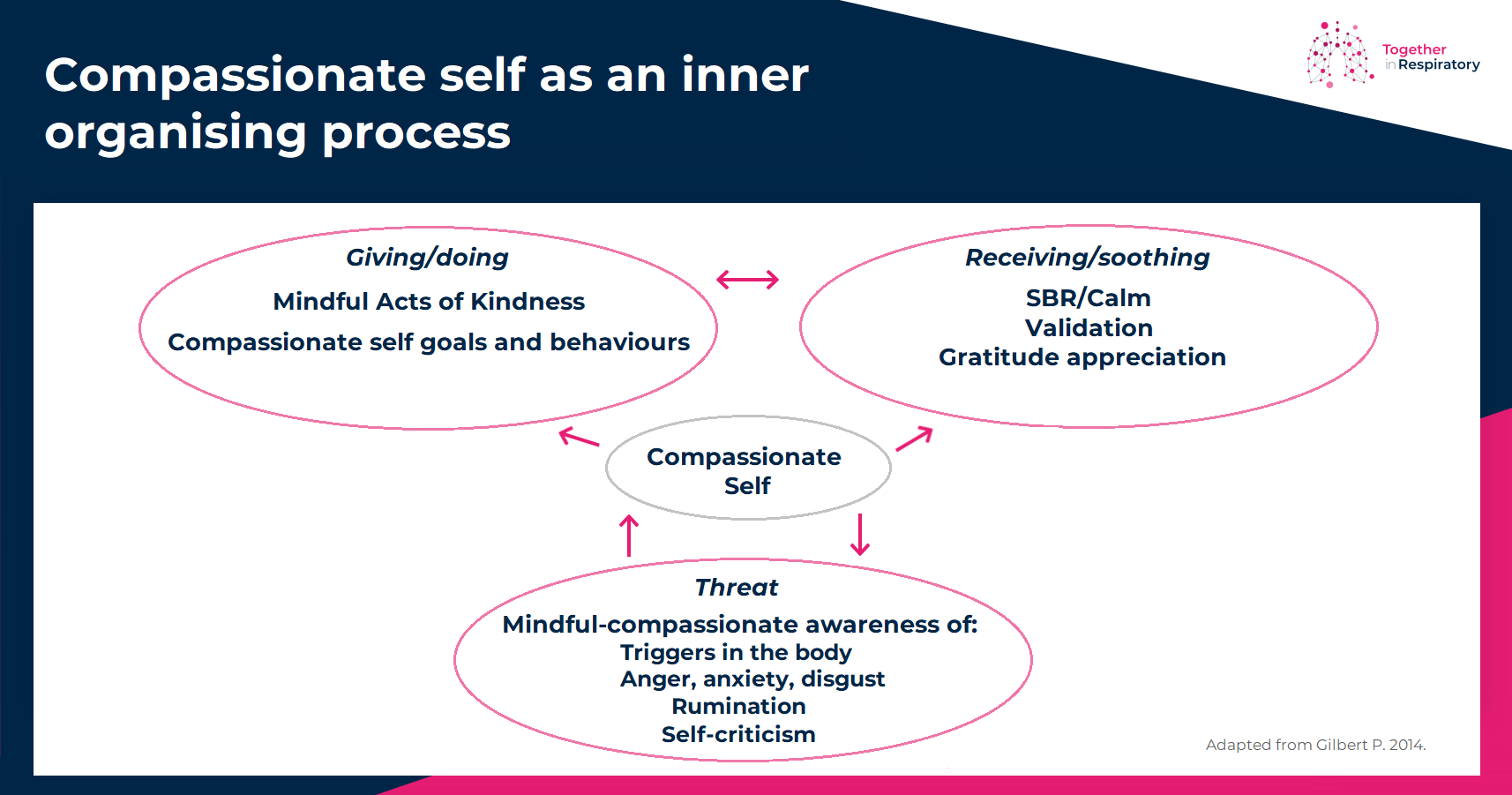
The psychological burden of respiratory symptoms for people living with lung conditions cannot be underestimated. Alongside the medical and pharmacological treatments available for respiratory illness,[1] other essential tools for alleviating and managing a patient’s psychological burden of their illness need to be more accessible – both for healthcare professionals and patients.
As nurses, we all too often witness the anxiety, frustration, fear, anger, helplessness, shame and self-criticism our patients experience.[2] I think, it may be argued, that these cannot be adequately explored within a 30-minute clinic appointment.
Yet we need resources to offer to people who are living with the reality of their prognosis. Our patients need ways to deal with the distress of respiratory symptoms – to navigate the complex world of emotions that accompany their disease.
A therapeutic approach
People living with lung conditions are often overlooked and their condition isn’t diagnosed at an early stage.[3] Empowering individuals to understand their internal psychological responses to symptoms, and to realise they can access powerful inner resources, could be one way of better supporting our patients to live with and accept their condition.
Compassion-focused therapy (CFT) may offer just this. Developed over 20 years ago by the British clinical psychologist Paul Gilbert, it aims to help people access their compassionate self to bring acceptance to their emotions, thoughts and goals and to regulate their response to threat.[4],[5]
Emotion regulation systems
Imagine John, who has idiopathic pulmonary fibrosis, is on a crowded bus. He begins to cough uncontrollably. His thoughts quickly turn to “I need to cough. I can’t breathe properly.” His anxiety builds and his nervous system is activated in response. His coughing increases. His thoughts continue. “This is so embarrassing, people will think I have COVID, everyone is looking at me, I’m a burden.” Over time, John avoids going out or being in social situations, which negatively impacts his confidence and wellbeing.[2] This is an example of what Gilbert calls ‘the threat system’, which describes the emotional responses arising in humans in reaction to danger and threat.[5]
The evolution of the human brain (described by Gilbert as ‘the tricky brain’) has given us complex reasoning abilities. It is these emotional responses, combined with our capacity to attach shame-based or self-critical narratives to our thoughts and emotions, which further activate the threat system and increase distress.[5]
Alongside the human propensity to detect and respond to danger, Gilbert argues, are our equal abilities to both soothe our emotions and direct them toward valuable goals. Learning to access our soothing system (receiving/soothing) helps us to feel:[5],[6]
- safe
- connected to others
- more able to exercise self-compassion in the presence of difficult emotions.
Alongside this, our drive system (giving/doing) functions to seek out the things that aid our survival and build our motivation and pleasure in life, such as learning a new hobby or building relationships with others.[6]

Using compassion-focused therapy
CFT helps people to access their compassionate self, an internal orientation whereby an individual can accept and endure challenges as part of the human condition, and to find ways to alleviate or prevent it wherever possible.[5],[7] By bringing compassionate awareness to their threat system, an individual has the capacity to balance their emotions by accessing the soothing system. Without our soothing system, our threat and drive systems become overactive.[8]
CFT draws upon a variety of interventions such as breathwork, posture, mindfulness, compassionate self-visualisation exercises and letter writing.[5] It differs from other approaches in that it seeks not only to reduce our negative responses, but to also build and broaden our capacity to accept challenges, practice self-compassion and direct emotions in ways that support wellbeing and reduce distress.[5]
The benefits of compassion-focused therapy
There is growing evidence for the benefits of CFT for people with a variety of long-term conditions.
Several systematic reviews have investigated the effectiveness of compassion-based interventions for people with chronic physical conditions.[9],[10] Austin et al reported that CFT interventions improved self-compassion and health-related quality of life, and reduced depression and anxiety, but suggested more research is needed to examine the impact of long and short-term interventions, and further tailored studies are required to target different populations.[9]
Currently, the COMFORT trial is underway to investigate the impact of CFT and breathing pattern retraining for people diagnosed with cancer recurrence during COVID-19.[11] Most recently, a systematic review and meta-analysis found CFT reduces clinical symptoms in mental health patients and shows promising potential for increasing self-compassion and compassion-related outcomes.[12]
Conclusion
As of yet, it appears there is a lack of compassion-focused intervention studies for respiratory patients, with mindfulness interventions delivered to respiratory patients unable to produce conclusive results.[13] My hope, for the patients I have seen and for all people living with respiratory conditions, is for more research in this area.
Coming alongside people to navigate these emotions is as important as the management of the physical symptoms. We need more resources to support people, and ultimately, more compassionate care.
Any advice given and opinions expressed in this article are those of the author and do not reflect the view of Chiesi Limited (Chiesi). All content in this article is for informational and educational purposes only. Although Chiesi strives to always provide accurate information, it is not responsible for and does not verify for accuracy any of the information contained within.
[1] Asthma + Lung UK. Treatments for lung conditions. Available at: https://www.asthmaandlung.org.uk/symptoms-tests-treatments/treatments
[2] Calderdale and Huddersfield NHS Foundation Trust. A compassionate approach to understanding breathing difficulties and emotional wellbeing. Available at: https://plr.cht.nhs.uk/download/1132/A%20compassionate%20approach%20to%20understanding%
20breathing%20difficulties%20and%20emotional%20wellbeing%20A4#:~:text=This%20booklet%20
explores%20common%20experiences,feel%20more%20familiar%20than%20others
[3] Asthma + Lung UK. Who we are. Available at: https://www.asthmaandlung.org.uk/about-us/who-we-are
[4] Leaviss J, Uttley L. Psychotherapeutic benefits of compassion-focused therapy: an early systematic review. Psychol Med. 2015; 45(5): 927-945
[5] Gilbert P. The origins and nature of compassion focused therapy. Br J Clin Psychol. 2014; 53(1): 6-41
[6] NHS. Persistent Physical Symptom Service. Available at: https://ppss-static.cumbria.nhs.uk/files/patient-resources/Worksheet-5.3-Threat-drive-soothe-system.pdf
[7] Craig C, Hiskey S, Spector A. Compassion focused therapy: a systematic review of its effectiveness and acceptability in clinical populations. Expert Rev Neurother. 2020; 20(4): 385-400
[8] NHS Foundation Trust. York Teaching Hospital. Self-Compassion and Pain Management. Available at: https://www.yorkhospitals.nhs.uk/seecmsfile/?id=7869
[9] Austin J, Drossaert CHC, Schroevers MJ, et al. Compassion-based interventions for people with long-term physical conditions: a mixed methods systematic review. Psychol Health. 2021; 36(1): 16-42
[10] Torbati AG, Zandi A, Abbaspour S. Effectiveness of educational intervention-based compassion therapy on emotional regulation and self-control after discharge of patients With COVID-19. J Educ Health Promot. 2022; 11: 279
[11] Lynch S, Lowry D, Finnerty C, O’Meara Y, Brennan D. The COMFORT trial: a randomised control trial comparing group-based COMpassion-FOcussed therapy and breathing pattern ReTraining with treatment as usual on the psychological functioning of patients diagnosed with cancer recurrence during COVID. Trials. 2023; 24(1): 89
[12] Millard LA, Wan MW, Smith DM, et al. The effectiveness of compassion focused therapy with clinical populations: A systematic review and meta-analysis. J Affect Disord. 2023; 326: 168-192
[13] Harrison SL, Lee A, Janaudis-Ferreira T, et al. Mindfulness in people with a respiratory diagnosis: A systematic review. Patient Educ Couns. 2016; 99(3): 348-355



 Jessica Millard
Jessica Millard 

